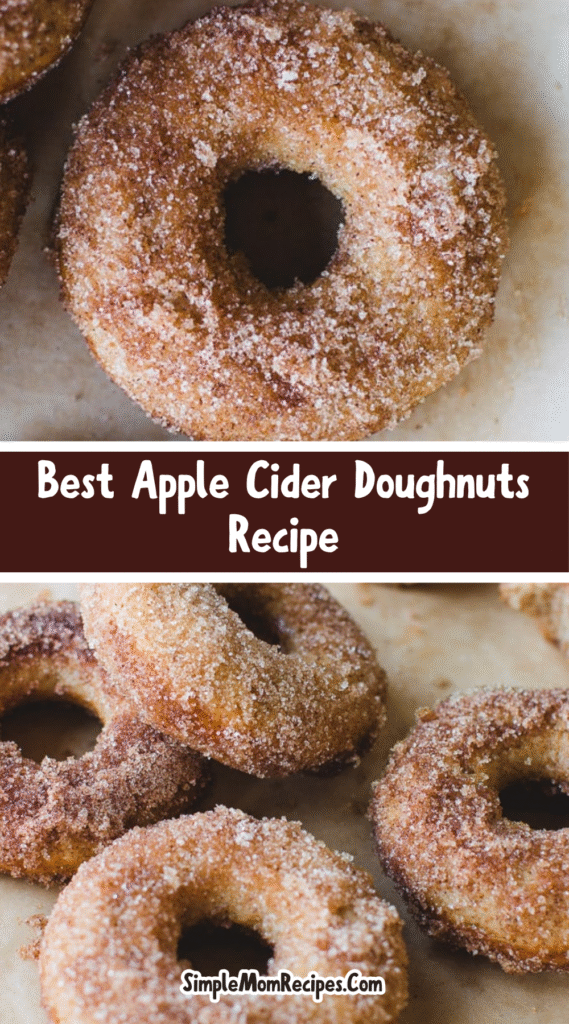There’s something truly magical about a perfect apple cider doughnut, isn’t there?
That crisp, sugary shell giving way to a tender, spiced interior is pure autumn joy. This recipe, from Kelsey, is a labor of love that delivers an incredible, fresh-apple flavor in every single bite.
Ingredients Needed for the Recipe
Gathering your ingredients is the first step toward doughnut bliss.
Having everything measured and ready makes the process smooth and simple.
- 13 1/2 ounces (about 3 cups) bleached all-purpose flour
- 1/2 ounce (1 tablespoon) sugar
- 1 1/4 teaspoons Diamond Crystal kosher salt
- 1 1/2 teaspoons instant dry yeast
- 1/4 teaspoon freshly grated nutmeg
- 1/4 teaspoon ground cinnamon
- 1/4 teaspoon baking soda
- 1/8 teaspoon ground cloves
- 9 ounces (about 1 cup + 2 tbsp) fresh apple cider
- 1 1/2 teaspoons rose water (optional, but lovely)
- 1/8 teaspoon almond extract (also optional)
- 2 ounces hazelnut oil or brown butter
- Refined coconut oil, for frying
- 1 recipe Apple-Cinnamon Sugar (for coating)
Why Use Fresh Cider Instead of a Reduction?
Many recipes have you boil cider down for hours into a thick syrup. Honestly, that method always felt a little backwards to me.
You lose that bright, orchard-fresh flavor, trading it for something deeper and almost caramelized—which is nice, but it’s not the vibrant apple taste we’re after here. Using fresh cider preserves that wonderful, fruity essence perfectly.
How to make The Best Apple Cider Doughnuts Recipe?

Making the Dough
This part is incredibly easy, thanks to your food processor. Pulse your dry ingredients together first—the flour, sugar, yeast, spices, and salt.
Then, with the machine running, pour in the fresh cider and those optional flavorings; let it whir until a soft, sticky dough forms. Finally, drizzle in the hazelnut oil and process just until it’s all combined.
Proofing the Dough
Now, transfer that slightly oily, shaggy dough into a greased bowl. Cover it up and let it rest in a warm spot.
You’re waiting for it to become puffy and light, roughly doubling in size. A gentle poke should leave an impression that slowly springs back—this usually takes about two hours.
Forming the Doughnuts
Time to get rolling! Turn the dough out onto a floured surface and roll it to just under 1/2 an inch thick. This is a key step, so grab a ruler if you need to.
Use a 3-inch cutter for the rounds, and a 1-inch cutter for the holes. You can also just poke a hole and stretch it with your fingers for a charming, rustic look.
The Second Rise
Place your beautiful doughnut rings on a greased baking sheet and cover them again. Let them have another nap until they puff up to about 3/4 of an inch high.
They should feel light and airy, yet still have a little resilience when you touch them. This second proof takes about an hour.
What’s the Best Oil for Frying Doughnuts?
Not all oils are created equal when it comes to frying. You want a solid fat, like refined coconut oil.
Why? Because it’s solid at room temperature, so it sets on the cool doughnut, giving a rich feel without any greasy residue. Plus, it has a high smoke point and won’t make your whole house smell like a fryer.
Frying the Doughnuts
Heat your oil to a precise 365°F—a clip-on thermometer is your best friend here. Gently slip a few doughnuts into the hot oil, don’t crowd them.
Fry for about 90 seconds per side, turning them until they’re a beautiful, even pale gold. Always do a test doughnut first to check your timing!
To Serve
The final, and most fun, step! While the doughnuts are still warm, dredge them in that homemade Apple-Cinnamon sugar.
Coat both sides thoroughly for that classic, crackly sweet finish. Enjoy them immediately, with a hot mug of cider for the ultimate experience.
Tips
Pay attention to the dough, not the clock. Proofing times are just estimates; the real cue is how the dough looks and feels.
Keep your oil temperature steady. If it drops too low, the doughnuts will be greasy; too high, and they’ll burn outside while staying raw inside.
Don’t skip the Apple-Cinnamon Sugar topping. It provides a huge burst of fresh apple flavor the moment you take a bite.
How to Store and Keep Them Fresh
Let’s be real, these are best devoured the day they’re made, ideally within an hour of frying. But if you must save some, cool them completely first.
Store them in a single layer in an airtight container at room temperature for a day. They’ll soften, but a quick warm-up in a toaster oven can bring back a little magic.
Can I Make the Dough Ahead of Time?
Absolutely, yes! This is a fantastic trick for a busy morning. After the first rise, you can punch the dough down.
Cover the bowl tightly with plastic wrap and pop it in the refrigerator overnight. In the morning, let it come to room temperature, then roll, cut, and proof as usual.
Fun Variations to Try
Once you’ve mastered the classic, feel free to play around! A dash of cardamom instead of cloves adds a wonderful, floral warmth.
For a decadent twist, dip the warm doughnuts in a simple cinnamon glaze instead of the sugar. Or, for a nutty crunch, roll them in a mix of sugar and finely chopped toasted pecans.

Best Apple Cider Doughnuts Recipe
Description
These homemade apple cider doughnuts are a fall favorite—light, crisp, and bursting with fresh apple flavor. Unlike traditional cake-style versions, these yeast-raised doughnuts use real, un-reduced apple cider in the dough and a vibrant topping made with freeze-dried apples for that orchard-fresh taste. Perfectly spiced and golden fried, they’re best enjoyed warm with a mug of hot cider.
Ingredients
For Frying & Topping
Instructions
Making the Dough
-
Combine flour, sugar, salt, yeast, nutmeg, cinnamon, baking soda, and cloves in a food processor. Pulse to mix evenly.
-
With the processor running, add apple cider, rose water (if using), and almond extract (if using) all at once. Process for about 50 seconds until a soft, sticky dough forms.
-
Add hazelnut oil or brown butter while processing and blend for another 10 seconds until fully incorporated. The dough will be slightly oily but cohesive.
Proofing the Dough (First Rise)
-
Transfer dough to a lightly greased bowl, cover with plastic wrap, and let rise at room temperature (around 70°F/21°C) until puffy and doubled in size, about 2 hours.Dough should spring back slowly when gently pressed.
Forming the Doughnuts
-
Turn dough onto a floured surface and roll out to 12mm (just under 1/2 inch) thick using a rolling pin.Use a ruler for accuracy to avoid thin or overly thick doughnuts.
-
Cut into 3-inch rounds using a cookie cutter. Remove centers with a 1-inch cutter or by hand to form rings.Place on a greased baking sheet. Knead scraps, let rest 5 minutes, then reroll and cut remaining doughnuts.
Second Rise
-
Cover doughnut rings with plastic wrap and proof until risen to about 18mm (just over 3/4 inch), light and resilient—about 1 hour at room temperature.Do not overproof; dough should not feel fragile.
Preparing the Oil
-
Pour refined coconut oil into a Dutch oven to a depth of 3 inches. Heat over medium to 365°F (185°C), using a digital thermometer to monitor temperature.Line a baking sheet with paper towels for draining fried doughnuts.
Frying the Doughnuts
-
Once oil reaches 365°F, fry one test doughnut first—about 75–90 seconds per side—until golden brown.Check inside: it should be cooked through without being dense or greasy.
-
Adjust oil temperature if needed. Fry 4–5 doughnuts at a time, turning occasionally for even color.Keep oil between 350–365°F during frying.
-
Remove with tongs, drain on paper towels, and let cool slightly before coating.
Coating and Serving
-
Place apple-cinnamon sugar in a wide dish. While doughnuts are still warm, dip both sides to coat generously.Serve immediately for best texture and flavor.
Nutrition Facts
Servings 14
- Amount Per Serving
- Calories 320kcal
- % Daily Value *
- Total Fat 12g19%
- Saturated Fat 9g45%
- Sodium 280mg12%
- Potassium 85mg3%
- Total Carbohydrate 48g16%
- Dietary Fiber 1g4%
- Sugars 16g
- Protein 4g8%
- Calcium 30 mg
- Iron 2 mg
* Percent Daily Values are based on a 2,000 calorie diet. Your daily value may be higher or lower depending on your calorie needs.
Note
- Fry oil tip: Refined coconut oil solidifies when cool, preventing greasy texture. Store and reuse for future batches.
- No 1-inch cutter? Use a bottle cap or small glass to form holes by hand for a rustic look.
- Apple-Cinnamon Sugar: Blend 1 cup sugar with 2 tbsp ground cinnamon and 1/4 cup crushed freeze-dried apples for intense fresh-apple flavor.
- Storage: Best eaten same day. Reheat briefly in toaster oven to refresh.
